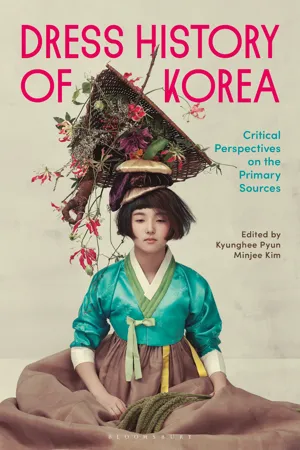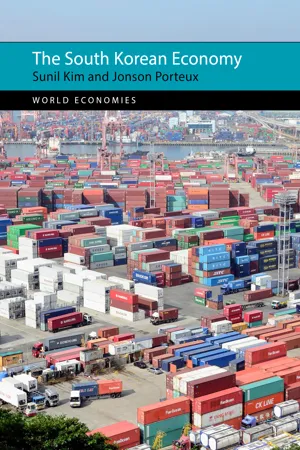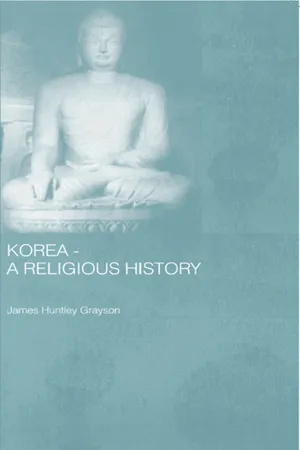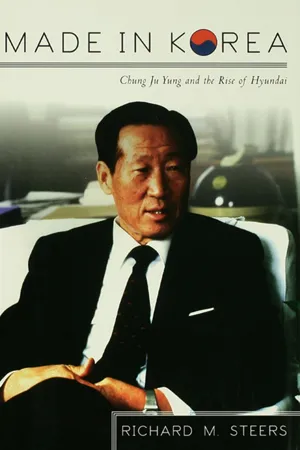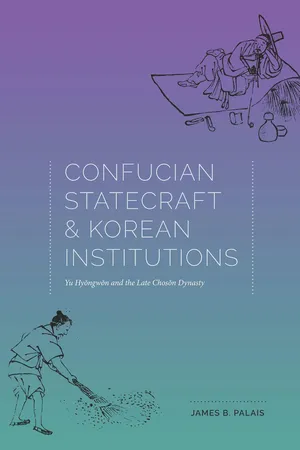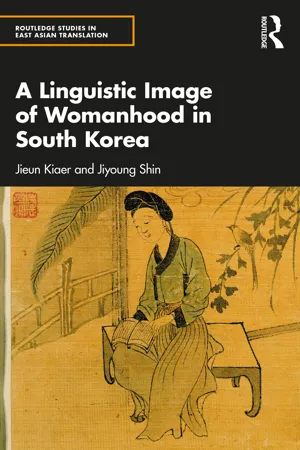History
Goryeo Dynasty
The Goryeo Dynasty was a medieval Korean kingdom that ruled from 918 to 1392. It was a time of significant cultural and technological advancements, including the development of movable metal type printing and the flourishing of Buddhism. The dynasty also saw conflicts with neighboring states, particularly the Mongol invasions in the 13th century.
Written by Perlego with AI-assistance
Related key terms
Related key terms
1 of 4
Related key terms
1 of 3
7 Key excerpts on "Goryeo Dynasty"
- eBook - ePub
Dress History of Korea
Critical Perspectives on Primary Sources
- Kyunghee Pyun, Minjee Kim(Authors)
- 2023(Publication Date)
- Bloomsbury Visual Arts(Publisher)
3
Jaeyoon YiGoryeo (918–1392): Dress in Literature, Bulbokjang, and Visual Arts“Korea,” the current name of the country, originated in the Goryeo Dynasty (高麗 , 918–1392), which was a bridge between ancient Korea and the Joseon dynasty (1392–1910). The founder, King Taejo (Wang Geon, r. 918–43), overthrew the Late Goguryeo (Hugoguryeo 後高句麗 , 901–18), resettled refugees from Balhae (渤海 , 698–926) after her collapse in 926, and received successive surrenders from Silla (新羅 , 57 BCE –935 CE ) in 935 and Late Baekje (Hubaekje 後百齋 , 892–936) in 936. The Korean peninsula was reunified by Goryeo with territorial expansion to the north, locating its capital in Songdo, present-day Gaeseong in North Korea (see Figure 1.1d ).While Buddhism played a dominant role in the multiple realms of people’s lives and culture as the state religion, Goryeo’s political system was based on Confucianism.1 King Gwangjong (r. 949–75) began to institute the state-wide examination (gwageo 科擧 ) to select government officials based on Confucian knowledge in 958, and issued the dress code (gongbok 公服 ) for officials in 960. In 992, King Seongjong (r. 981–97) established the National Confucian Academy (Gukjagam 國子監 ) to foster the state’s workforce based on Confucian scholarship. For 474 years of the dynastic span, the dress culture of Goryeo was closely interwoven with the state’s political and diplomatic policies. The regulations on dress were set off on the bases of two underlying ideas—Buddhism and Confucianism as the order system within Goryeo society as well as extended to foreign relations with the Chinese Song (宋 , 960–1279), Ming (明 , 1368–1644), Liao (遼 , 916–1125), Jin (金 , 1115–1234), and Yuan (元 , 1271–1368) dynasties.2 - eBook - ePub
- (Author)
- 2019(Publication Date)
- Lonely Planet(Publisher)
cheonmin and who lived a caste-like existence, often in separated and ostracised villages, and whose status fell upon their children as well. Likewise, slavery was hereditary (matrilineally), with slaves making up as much as 30% of Goryeo society.The Goryeo aristocracy admired and interacted with the splendid Chinese civilisation that emerged during the contemporaneous Song dynasty (960–1279). Official delegations and ordinary merchants took Korean gold, silver and ginseng to China in exchange for silk, porcelain and woodblock books. Finely crafted Song porcelain stimulated Korean artisans to produce an even finer type of inlaid celadon pottery – unmatched in the world before or since for the pristine clarity of its blue-green glaze and the delicate art of its inlaid portraits.Buddhism was the state religion, but it coexisted with Confucianism throughout the Goryeo period. Buddhist priests systematised religious practice by rendering the Korean version of the Buddhist canon into mammoth woodblock print editions, known as the Tripitaka . The first was completed in 1087 after a lifetime of work, but was lost. Another – the Tripitaka Koreana – was completed in 1251.In 1971 the tomb of King Muryeong, the longest-ruling Baekje king, was discovered in Gongju. It contained a wealth of funerary objects that had not seen the light of day in 1500 years, including remains of the king and queen’s wooden coffins, golden diadem ornaments, jewellery, clothing accessories and the king’s sword.The Rise of the Mongols
This high point of Goryeo culture coincided with internal disorder and the rise of the Mongols, whose power swept most of the known world during the 13th century. Korea was no exception, as Kublai Khan’s forces invaded and demolished Goryeo’s army in 1231, forcing the government to retreat to the island of Ganghwado, a ploy that exploited the Mongol horsemen’s fear of water.After a more devastating invasion in 1254, in which countless people died and around 200,000 people were taken captive, Goryeo succumbed to Mongol domination and its kings came to intermarry with Mongol princesses. The Mongols then enlisted thousands of Koreans in ill-fated invasions of Japan in 1274 and 1281, using craft made by Korea’s great shipwrights. The Kamakura Shogunate turned back both invasions with help, as legend has it, from opportune typhoons known as kamikaze - eBook - ePub
- Sunil Kim, Jonson Porteux(Authors)
- 2022(Publication Date)
- Agenda Publishing(Publisher)
Despite the much earlier origins of what would become Korea, most scholars point to the Goryeo Dynasty (918–1392) as the key point in Korea’s modern emergence as a rationalized state. The Goryeo period was then replaced by the Joseon dynasty (1392–1910), which governed the peninsula until it began to slowly erode as principally a result of corruption and inefficiency (see Cumings 1997). The Joseon dynasty’s descent coincided with Japan’s emergence as a major regional power, thus setting the stage for the colonial period in which Japan replaced Korean-domestic rule by fully annexing it in 1910 and then governing the entirety of the peninsula until its defeat at the end of the Second World War in 1945. By the time Korea had been annexed, Japan itself was immersed in its own decades-long efforts against its potential colonization by foreign powers, which had in large part precipitated the end of the Tokugawa period (1603–1868) and advent of the Meiji era (1868–1912), in which its traditional government and economy was replaced by a more modern, Western-influenced one, with the goal and ultimate realization of rapid industrialization. And one of the key arguments made by scholars of this era (to be discussed below) is that Japan closely replicated a similar transformation of the peninsula. Building upon the work of scholars such as Cumings (1987), McNamara (1990), Eckert (1991) and Woo (1991), among others, Kohli’s (1994) oft-cited essay makes a provocative, although contested, argument that Korea’s 1960 take-off (and basically Korean-style capitalism in general) owes its origins to this period of Japanese rule – linking the formation of Korea’s developmentalist approach to the Japanese-led dismantling of Korea’s traditional system and, in its place, the creation of a “mini-Japan” (Kohli 1994 : 1285) – predicated upon a heavy state-interventionalist model (i.e - eBook - ePub
- James H. Grayson(Author)
- 2013(Publication Date)
- Routledge(Publisher)
Part II The Koryŏ DynastyPassage contains an image
5 The Early Koryŏ Period (935-1200)
DOI: 10.4324/9781315029405-71 The Historical Background
With the founding of the Koryŏ Dynasty in the first third of the tenth century, Korean history entered a new phase. The accumulated social and political trends of the last century and a half burst out to create the framework of a new society, Koryŏ. The start of the new dynasty may be dated to 935, when Silla’s last king Kyŏngsun (r. 927–35) surrendered to T’aejo (r. 918–43), founder and first king of the new state. Later Paekche was conquered in 936, and the realm which had been Unified Silla was once again one nation (see Fig. 9 ).Figure 9 Early Koryŏ (Tenth Century)The rise of Wang Kŏn (877–943), known by his regnal name as T’aejo, was a reflection of the increased strength of the local landholders and the mercantile class in contrast to the decline of the aristocracy. Under King T’aejo the boundaries of the state were secured and expanded. The importance of P’yŏngyang as a strategic centre was re-emphasized with the placement of a major garrison there. Defensive preparations were made against a possible invasion by the Khitan tribes to the north, and plans were laid to seize the northern territories which had belonged to the Kingdom of Koguryŏ. These plans indicate the importance of the former state of Koguryŏ to Koryŏ, which saw itself as the successor of both Koguryŏ and Parhae as well as the successor of Silla. This attitude resulted in a northward emphasis in foreign policy. Upon T’aejo’s death in 943, the king left a testament, the Hunyo sipcho (Ten Injunctions), in which he set out ten guide-lines for his successors. These guide-lines reflected both the king’s Buddhist piety and his shrewd understanding of politics and human nature.The years immediately following the death of the founding king were consumed in a bloody rivalry for the succession to the throne. King Kwangjong (r. 949–75) ruthlessly suppressed the opposition and simultaneously set in motion a reformation of the government which limited aristocratic power and strengthened the authority of the monarch. Kwangjong also freed the slaves, which had the effect of both undermining the power of the aristocrats and vastly increasing the tax revenues of the government. - eBook - ePub
Made in Korea
Chung Ju Yung and the Rise of Hyundai
- Richard M. Steers(Author)
- 2013(Publication Date)
- Routledge(Publisher)
koryo (“ko-ree-o”).CHOSON AND THE SEJONG RENAISSANCEAs is typical of most dynastic shifts, a period of war and rebellion preceded the emergence of the new Yi dynasty. A Mongol invasion and accompanying civil unrest led to the emergence of General Yi Song-gye, who first reestablished order and then proceeded to overthrow the last remnants of the Koryo dynasty and establish his own. The new ruler promptly resumed diplomatic and tributary relations with Ming China and took the ancient Chinese name for Korea, Choson, meaning “Land of the Morning Calm.” Because of this, the Yi dynasty is also referred to as the Choson dynasty. To solidify control over his empire, Yi built a new walled capital city in the center of his kingdom in an area surrounded by high mountains that provided a natural defense against outside attacks. The new city was called Seoul.Despite its militaristic origins, the Yi dynasty was marked by further cultural and economic developments. A noteworthy period of this era was that of King Sejong in the first half of the fifteenth century. King Sejong was born in 1397 and ruled Korea from 1418 to 1450. During his reign, he oversaw the development of many progressive ideas in administration, linguistics, music, science, and humanistic studies. He established the Hall of Talented Scholars (Chiphyonjon) to promote research in institutional traditions, politics, and economics. In 1443, he developed a new Korean alphabet, known as hangul, as a way to reflect the Korean language accurately in writing. Heretofore, Korean sounds had been forced awkwardly into traditional Chinese characters, even though Chinese was based on an entirely different linguistic system. Sejong intended this new alphabet to be used to educate the populace to read and write. Indeed, the first manuscript describing the alphabet (in 1446) was called “Correct Sounds to Teach the People” (Hunmin Chong-um - eBook - ePub
Korean Studies of the Henry M. Jackson School of International Studies
Yu Hyongwon and the Late Choson Dynasty
- James B. Palais(Author)
- 2014(Publication Date)
- University of Washington Press(Publisher)
Koryŏ kings were virtual puppets under a succession of military commanders since the military coup of 1170, and after a brief exile on Kanghwa Island while the Mongols ran rampant and unopposed over Korean territory on the peninsula, they once again became pawns, this time in the hands of Mongol overlords from 1258 to 1355. During that period the military disappeared as a serious political force and the kings retained some authority, but they were able to offer little resistance against the emergence and domination of the Koryŏ state by the yangban families who dominated the central bureaucracy, the estate owners, and slaveholders. 1 The Neo-Confucian supporters of Yi Sŏnggye proposed a program to reverse all these problems, and they did so from a feeling of moral outrage. They fully supported the creation of a bureaucratic monarchy to a level of prestige and power that surpassed anything that had been seen since the military dictatorship of Yŏn Kaesomun in the mid-seventh-century Koguryŏ dynasty. They did so not because they admired tyranny, but because they saw a more powerful king as the agent who would break the domination of hereditary yangban aristocrats of Koryŏ by requiring passage of the civil service examination as mandatory for appointment to the most prestigious offices. Once the new dynasty was in place, they expected to restrain the tendency toward arbitrary and tyrannical rule by subjecting the king to the ethical admonishments of his Confucian advisers and remonstrance officials. Since the central bureaucracy would hence be the exclusive locus of men educated in the Neo-Confucian canon, they planned to expand central, bureaucratic control over the whole country by requiring that all district magistrates be appointed from the pool of regular officials at the capital - eBook - ePub
- Jieun Kiaer, Jiyoung Shin(Authors)
- 2022(Publication Date)
- Routledge(Publisher)
2WOMANHOOD IN A NEO-CONFUCIAN SOCIETY – PAST AND PRESENTDOI: 10.4324/9781003197287-22.1 Introduction
There have been strict rules about gender on the Korean peninsula for many hundreds of years. In order to understand the current situation in Korea, we must look back to the Joseon dynasty (1392–1897) and the rules for each gender at the time. In doing so, we begin to understand how echoes of the past remain in Korea’s modern society. Rules for the behaviour of women are no longer explicitly decreed in South Korea, but implicit standards still exist.Women were not always in a disadvantageous position. Before the Joseon dynasty women were treated fairly equally in comparison to men, as we will see. This all changed when Neo-Confucianist doctrines entered Korea from China. The Joseon dynasty was founded by high officials of the previous Goryeo Dynasty (918–1392). Joseon’s founding fathers condemned the decadent lifestyles of the Goryeo Dynasty and saw women’s rights as one of the hidden causes of Goryeo’s destruction. Therefore, they wanted to make sure that men’s and women’s roles were clearly divided and that women were understood as inferiors in society whose main roles were to perform ancestral rites and look after domestic family affairs.2.2 Transition From Goryeo
During the Goryeo Dynasty, restrictions on women’s behaviour were not so severe. Women were fairly free to express themselves and move around in society. In contrast to the strict promotion of chastity as a core value for proper womanhood during the Joseon dynasty, tales of romance and women’s sexual freedom were common in the Goryeo period. For example, the song ‘Ssanghwajeom’ (雙花店) was even sung at royal parties by King Chungnyeol of Goryeo (1236–1308, r. 1274–1308). King Chungnyeol was king during the Mongol invasions and was known as one of the most decadent kings of the Goryeo Dynasty.
Index pages curate the most relevant extracts from our library of academic textbooks. They’ve been created using an in-house natural language model (NLM), each adding context and meaning to key research topics.
Explore more topic indexes
Explore more topic indexes
1 of 6
Explore more topic indexes
1 of 4
